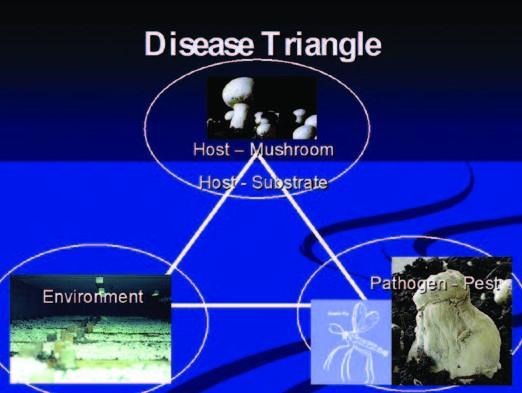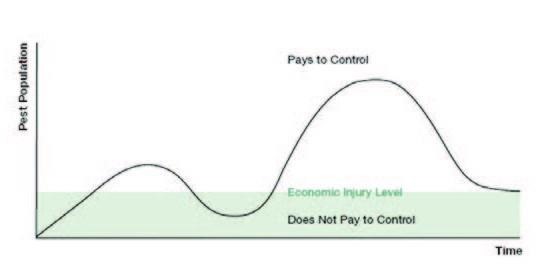By David Meigs Beyer and John A. Pecchia
Integrated pest management (IPM) is an approach to pest control that focuses on pest prevention by eliminating the root causes of pest problems with technical and management methods to effectively suppress or prevent pest populations in a safe, cost-effective, and environmentally sound manner.
What are the advantages of IPM? IPM programs have proved to significantly reduce risks related to pesticides while improving the quality, health, and welfare of the environment and people.
- IPM reduces the environmental risk associated with pest management by encouraging the adoption of more ecologically benign control tactics.
- IPM minimizes disease resistance. Resistance must be evaluated with respect to the natural variation among individuals and populations in their abilities to detoxify a pesticide.
- Organic production allows pest control with the use of OMRI-approved materials.
Why Is IPM Important for Mushroom Production?
IPM techniques are key to mushroom growing because the crop is grown inside climate-controlled buildings. This offers two advantages over other crops: (1) control of the growing room’s internal environment, which is important for the exclusion of many pests, and (2) manipulation of temperature and humidity.
How Do We Implement IPM?
IPM follows a stepwise approach:
- Understand the disease triangle concept
- Identify the pest
- Know the enemy
- Determine the economic threshold
- Develop an effective preventive control strategy
- Monitor pest and disease populations
- Evaluate and follow up
Understand the Disease Triangle Concept
A disease is a sustained or progressive impairment of an organism’s cells or tissues that causes structural or functional abnormalities. A disease occurs when a disease-causing agent, or pathogen, meets the right host organism under environmental conditions favorable for disease development.
These three elements—pathogen, host, and environmental conditions—make up the disease triangle (Figure 1). The disease triangle is a concept that illustrates the importance of all three critical factors necessary for disease to develop.

Figure 1. Disease triangle.
First, a pathogen must be present in the environment. Disease-causing plant pathogens include fungi, viruses, bacteria, and other microbes. Next, a pathogen must come in contact with a susceptible host. Pathogen-host interactions are often very specific. If an appropriate host cannot be found, the disease will not be present since the pathogen is missing its food source. Finally, the right environmental conditions must be present for the pathogen to cause disease.
Identify the Pest
The first step in solving any pest problem effectively and safely is the correct identification of the pest.
Know the Enemy
It is key to know the kind of pests you have and where they are coming from. Since each pest has different habits, biology, and life cycles, its positive identification will lead to more effective control.
Determine the Economic Threshold
Mushroom growers integrate multiple control strategies, as in an IPM program, but they must also make decisions in relation to pest population dynamics, or determine the economic threshold and economic injury level (Figure 2).

Figure 2. Graph showing economy injury level.
The level of pest density that can be tolerated is both a management and a subjective decision. Not every farm is the same. A pest presence does not always cause enough significant damage to warrant control. The level at which the pest population will cause significant damage is known as the economic threshold (ET). This means the pest population has reached levels at which you should take action and begin control measures to prevent pests from reaching the economic injury level (EIL), which is when losses caused by pest population are equal to the cost of control. The ET must be set below the EIL for the control practice to be profitable.
Pest sightings are recorded to document where and when the problems occur in order to identify and control vectors, and to determine the economic threshold of the pest to yield losses.
Develop an Effective Preventive Control Strategy
IPM typically uses several nonchemical tactics to deal with a pest. Preventing the conditions that pests need is critical to successful control. Because IPM focuses on prevention, it provides more effective long-term control than a reactive, spray-based approach to pest control.
- Physical/exclusion techniques help prevent the pest from reaching sites where it can create damage (e.g., sealing walls and cracks to prevent entry of flies). Air must be filtered before it enters the room.
- Cultural techniques make the environment less supportive of pests and more supportive of beneficial organisms. Composting is an excellent cultural IPM technique that strongly influences fungal competitors and pathogens. Instigation of shorter crop cycles is another IPM tool that strongly influences pest population dynamics. Also important is maintaining an environment, including proper temperature and relative humidity, that favors mushroom growth over the growth of its competitors.
- Biological techniques employ biologicals approved by the Organic Materials Review Institute (OMRI).
Monitor Pest and Disease Populations
New infestations can be controlled best if spotted early. With IPM, pest populations are monitored regularly.
Evaluate and Follow Up
Monitoring is essential for determining whether a management strategy is working and calls attention to times when strategies are not working as expected.
Organic IPM Control of Pathogens and Pests
Identification and understanding of the biology of pest organisms:
- Know the enemy
- Look for symptoms and signs
Sanitation/hygiene:
- Eliminate or reduce pathogen particles
- Control or eliminate vectors
- Control movement of personnel
- Cover infected mushrooms
Physical control:
Source : psu.edu